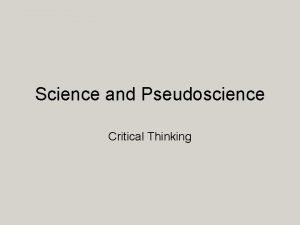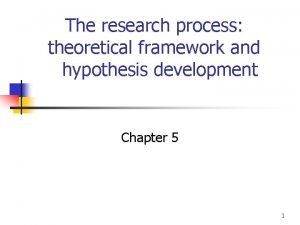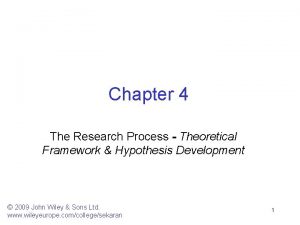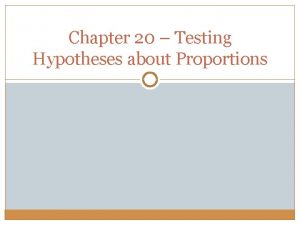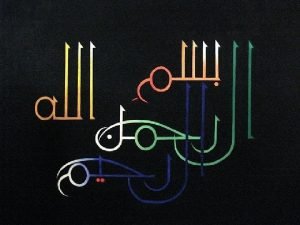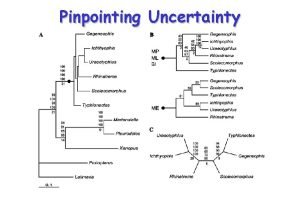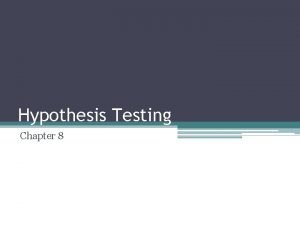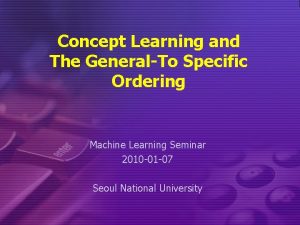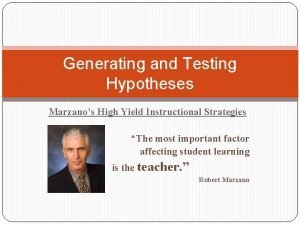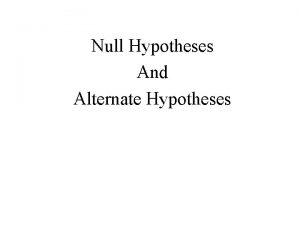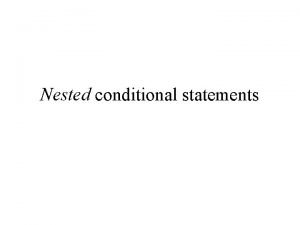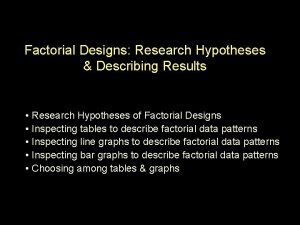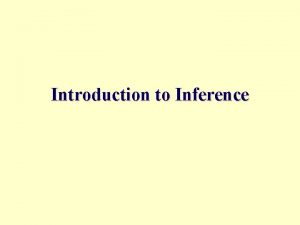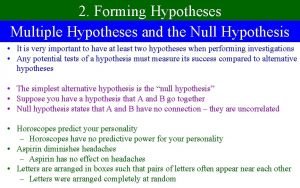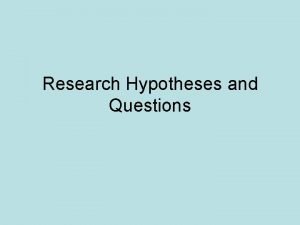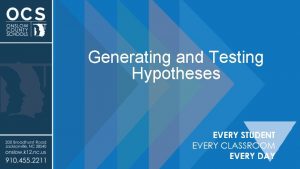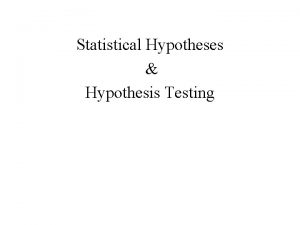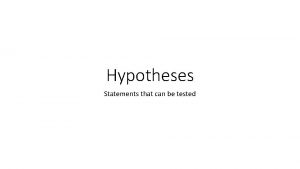Control Techniques The rival hypotheses discussed previously e










- Slides: 10

Control Techniques The rival hypotheses discussed previously (e. g. , history, testing, maturation, etc. ) can be controlled or eliminated using true experimental designs. There are other sources of error that may also threaten the internal validity of an experiment. Those additional sources of error are called subject and experimenter artifacts: intentional or unintentional behavior that may affect the outcome of an experiment.

Sources of Error Random error - the effects of uncontrolled variables that cannot be specifically identified, but are self-canceling. For example, some subjects may be better readers than others or some may be more comfortable working with computers. Systematic error - the effects of uncontrolled variables, often specifically identified, but are not self-canceling. For example, demand characteristics - cues in the experimental situation that lead subjects to guess or speculate about the hypothesis being tested. Random assignment usually controls random error, but not systematic error.

Subject Artifacts Subject artifacts are those motivations, behaviors, attitudes, etc. that subjects bring with them to the experiment. • • “good/cooperative” subject - one who attempts to guess how the experimenter wants him or her to act and does so. The subject may use demand characteristics (learned from textbooks, stories told on campus, talking with other subjects, etc. ). negativistic/uncooperative subject - one who attempts to guess how the experimenter wants him or her to act and behaves in the opposite manner.

Subject Artifacts (con’t) • • turkey subject - one who is unable to comply with the experimental procedures (you will never see this type of subject discussed in any textbooks). evaluation apprehension - the desire to look “good” in front of the experimenter.

Controlling Demand Characteristics Reduce the number of demand characteristics available to subjects: • • • use naturalistic or quasi-designs ask subject not to try figuring out what the experimenter wants use post-test only designs (no pretests). Evaluate the extent of the demand characteristics: • • use quasi-control subjects to role-play postexperimental interview

Experimenter Artifacts Experimenter artifacts are those behaviors and characteristics of the experimenter which may influence the results. Non-interactional Experimenter Effects - those that do not directly affect subjects’ behavior: • • • observer effect - differences in observational skill or consistency over time interpreter effect - differences occurring in the interpretation of data intentional effect - purposely falsifying data

Experimenter Artifacts (con’t) Interactional Experimenter Effects - those that directly affect subjects’ behavior: • • biosocial effect - influence of experimenter’s gender, age, race, etc. psychosocial effect - influence due to the experimenter’s personality on subjects situational effect - experience of administering task, acquaintance with subjects, etc. expectancy bias - influence of experimenter’s behavior toward subjects (e. g. , smiling, frowning, nodding, etc. ) in the direction of how the experimenter “expects” the subject should behave.

Controlling Experimenter Artifacts Clear-cut controls for experimenter artifacts do not exist. Use of objective DVs and prior practice can reduce observer effects, differences in data interpretation are not easily resolved, and you may never know if someone falsifies data. If biosocial effects are of concern, gender, age, and race could be included as IVs in the study. Minimizing experimenter interaction with subjects could help reduce psychosocial effects (e. g. , use printed instructions). Situational effects must be considered on a case-by-case basis. Expectancy bias is best controlled through the use of a doubleblind - subject and experimenter are naïve to the experimental conditions and hypothesis.

Additional Control Techniques Practice and rehearsal effects are of concern in many studies. The following techniques can be used to control for those effects: • counterbalancing - alternating the order of IV level presentation when a serial presentation is used. “Order, ” then, would be included as an IV in the experimental design. – Example. If you are requiring Ss to read two different passages, each followed by a recall test, half of the Ss should be given the 1 st reading then the 2 nd reading and the other half of the Ss are given the passages in the opposite order.

Additional Control Techniques • • random ordering of stimuli - using a random process to order a series of stimuli that are to be presented to subjects. “Order” is not, then, included as an additional IV in the design. – Example. Each subject would receive a different randomized order of 20 CVC-CVC paired-associates. filler task - any task (usually simple) that is unrelated to the IV(s) used to prevent Ss rehearsal or the presneted material. – Example. Give Ss a list of paired-associates (e. g. , A-B) followed by recall of the list. Repeat to criterion. Present filler task (e. g. , identifying even numbers in a random numbers table). Repeat A-B learning and measure “savings” scores.
 Ruling out rival hypotheses
Ruling out rival hypotheses Theoretical framework independent dependent variable
Theoretical framework independent dependent variable Example of null hypothesis
Example of null hypothesis Give the hypotheses for the following framework
Give the hypotheses for the following framework Chapter 20 testing hypotheses about proportions
Chapter 20 testing hypotheses about proportions Theoretical framework in quantitative research
Theoretical framework in quantitative research Analysis of competing hypotheses template
Analysis of competing hypotheses template Two types hypothesis
Two types hypothesis Explain general to specific ordering of hypothesis
Explain general to specific ordering of hypothesis Chapter 19 testing hypotheses about proportions
Chapter 19 testing hypotheses about proportions Marzano high yield instructional strategies
Marzano high yield instructional strategies
